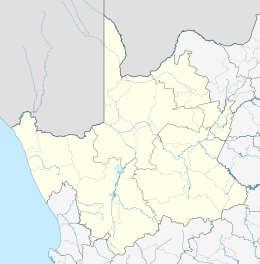Kuruman
| Kuruman | |
|---|---|
|
The Eye | |
 Kuruman  Kuruman  Kuruman
| |
| Coordinates: 27°27′35″S 23°24′45″E / 27.45972°S 23.41250°ECoordinates: 27°27′35″S 23°24′45″E / 27.45972°S 23.41250°E | |
| Country | South Africa |
| Province | Northern Cape |
| District | John Taolo Gaetsewe |
| Municipality | Ga-Segonyana |
| Established | 1887[1] |
| Area[2] | |
| • Total | 93.39 km2 (36.06 sq mi) |
| Population (2011)[2] | |
| • Total | 13,057 |
| • Density | 140/km2 (360/sq mi) |
| Racial makeup (2011)[2] | |
| • Black African | 23.5% |
| • Coloured | 43.7% |
| • Indian/Asian | 1.3% |
| • White | 30.3% |
| • Other | 1.2% |
| First languages (2011)[2] | |
| • Afrikaans | 76.9% |
| • Tswana | 14.9% |
| • English | 4.0% |
| • Other | 4.2% |
| Postal code (street) | 8460 |
| PO box | 8460 |
| Area code | 053 |
Kuruman is a town with 13,057 inhabitants in the Northern Cape province of South Africa. It is known for its scenic beauty and the Eye of Kuruman, a geological feature that brings water from deep underground. It was at first a mission station of the London Missionary Society founded by Robert Moffat in 1821. It was also the place where David Livingstone arrived for his first position as missionary in 1841. The Kuruman River, which is dry except for flash floods after heavy rain (see wadi), is named after the town.
Origins
The town is widely known as the ‘the fountain of Christianity’ in Africa, or the 'Oasis of the Kalahari', due to the flowing springs of Die Oog (the Eye of Kuruman), where a vast abundance of water reaches the surface in the Kalahari Desert. At the 'Moffat Mission' the Scottish missionary Robert Moffat was the first person to translate and print the entire Bible into the Setswana African language. He helped build the Moffat Church which was completed in 1838.
Location and climate
Kuruman was located along the border that bounds the Northern Cape from the North West Province and is still a local town for most communities surrounding the town, including those that live in the North West Province.
Kuruman has relatively mild weather patterns compared to other Northern Cape towns, such as Upington and Springbok, and is surrounded by more vegetation as compared to the Upington and Springbok, which are surrounded by desertic environments.
Demographics
According to the 2001 census, Kuruman had a population of 9,824, of which 4,267 (43.4%) were Coloured, 3,549 (36.1%) were White and 1,969 (20.0%) were Black. The most spoken language at home was Afrikaans at 80.68%, followed by Tswana at 14.8%. Males make up 50.58% of the population and females at 49.42%.[3]
Trivia
Kuruman is one of the more noted Peace Corps outposts in the northern regions of South Africa.[4] From 2007 to 2009, it was home to former Peace Corps volunteer and published author and playwright Stefanie DeLeo.[5]
The Kalahari Meerkat Project, made famous by the television series Meerkat Manor, is located nearby.
Kuruman is home to well-known local author and Sanusi or Zulu traditional healer, Credo Mutwa.
See also
- European exploration of Africa
- List of returned Peace Corps Volunteers
References
- ↑ Raper, R.E. Dictionary of Southern African Place Names. Internet Archive.
- 1 2 3 4 "Main Place Kuruman". Census 2011.
- ↑ "Main Place 'Kuruman Part 2'". Census 2001. Retrieved 10 January 2012.
- ↑ Peace Corps Northern Cape
- ↑ Stefanie DeLeo: Books, Biography, Blog, Audiobooks, Kindle.
External links
| Wikimedia Commons has media related to Kuruman. |
| Wikisource has the text of the 1911 Encyclopædia Britannica article Kuruman. |
- Visit Kuruman Travel Guide and Accommodation in Kuruman
- Kuruman on the Northern Cape Tourism Authority website

.svg.png)